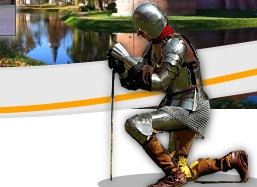| In around 1329, on a hill on the Guber
river, the Teutonic knight erected a wooden fort (Rastenburg).
It was raised on the charred remains of a Prussian fortified
village Rast, captured by the Knights in the 13th century.
Today that site is occupied by the fortified church of St
George. The purpose of the fort and its crew was to defend
that part of the Teutonic state against frequent Lithuanian
attacks; Rastenburg was also a staging post in crusades to
pagan Lithuania. The fort was twice conquered and burnt by
Lithuanians, first by troops commanded by duke Olgierd in
1345, and two years later by duke Kiejstut. Each time it was
reconstructed and the nearby settlement filled with new inhabitants.
The Commander of Bałga, Johan Schindekopf, granted a charter
to the settlement on 11th November 1357. At around the same
time the construction of a brick castle located in the south-east
corner of the town's fortified walls was undertaken.
Originally the castle consisted of three wings closed to the
east by a wall with a gate. The great hall contained a refectory,
rooms for the Teutonic official - procurator, and a chapel.
The castle was surrounded with a wall with three corner towers
and a gatehouse leading to the town. The castle and the adjacent
manor contained a kitchen, a brewery, a mill, a bakery, a
granary, a storehouse, an armoury, a powder magazine, a chapel
and a dungeon.
During the Thirteen Years' War, in 1454, the burghers overpowered
the castle. They imprisoned and then executed the Order's
Procurator Wolfgang Sauer. After 1525, in Ducal Prussia, the
castle was turned into a seat for the local administration
official known as a starosta.
At the end of January 1945, after the town had been seized
by the Red Army, the castle as well as most of the old town
of Kętrzyn were burnt. The castle was reconstructed in 1962-1967.
The external appearance of the castle was reproduced according
the19th century drawings made by C. Steinbrecht, which meant
that the castle regained its Gothic style.
At present the castle houses the Wojciech Kętrzyński Museum,
the Municipal Library and the Zamek Cultural Centre. The Museum
collects exhibits connected with the history of the town and
region. There are many arts objects, examples of craftsmanship
and exhibits recording the town's history and documents from
archives, which were preserved in the early post-war years
by Zofia Licharowa, who organised the museum. Many historically
priceless objects were saved from being damaged or dispersed.
They also included parts of interior decoration in palaces
and mansions near Kętrzyn, objects from damaged and looted
churches, the town council's archives, and remnants of the
pre-war collections of the Heimatenmuseum Rastenburg and the
Prussia Museum in Königsburg.
The Museum holds three permanent exhibitions: Wojciech Ketrzyński
1838-1918, Kętrzyn-Rastenburg 19th and 20th century - a forgotten
image, and Palaces and manors in the administrative district
of Kętrzyn.
The castle also houses an interesting collection of Gothic
sculpture, furniture of the 17th-19th century, a collection
of epitaphs and funeral banners, including a child's funeral
banner of three-year old Botho zu Eulenburg, dating back to
1667, which is a unique exhibit in Europe. The museum library
and archives contain a rich collection of books on religious
matters and a collection of documents from the former town
council's archives.
In front of the castle there is a commemorative plaque, which
reminds of the meeting of two Polish generals, J.H. Dąbrowski
and J. Zajączek, who commanded Polish troops under the French
emperor, Napoleon I Bonaparte. The generals and their soldiers
arrived in Ketrzyn on 21st June 1807 after the battle at Frydland
on 14th June 1807.
Wojciech Kętrzyński Museum
pl. Zamkowy 1, 11-400 Kętrzyn, Poland
tel. +4889 752 32 82, tel./fax 752 29 65, www.muzeum.ketrzyn.pl
|






![]()
![]() The
project is co-financed from the funds of the European Regional Development Fund,
under the framework of the Lithuania,
The
project is co-financed from the funds of the European Regional Development Fund,
under the framework of the Lithuania,